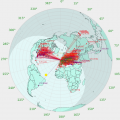The KiwiSDR 2 online store is open for orders! Please visit kiwisdr.nz
Please visit kiwisdr.com (documentation) and kiwisdr.nz (online store)
G8JNJ
About
- Username
- G8JNJ
- Joined
- Visits
- 3,860
- Last Active
- Roles
- Member
- Points
- 35
Reactions
-
A question for the signal theory experts (Preamplifier gain)
>
>broadband magnetic loop, digital mode, there was no obvious advantage beyond about 3db (lowest) increase in noise floor
>
That's highly likely.
Glenn was spot on with his previous statement.
>
> It is more difficult to approach propagated and galactic noise floors with a small antenna, whether loop or dipole. It may not even be possible at mid-upper HF given typical >site signal levels and available active devices
>
With your loops and LZ1AQ amplifier, I suspect that the antenna performance is likely to be about 10dB worse than the sensitivity required to hear the galactic noise floor on the upper HF bands, so as soon as you see the noise from the amplifier raising the KiWi noise floor, you won't really notice any further improvement.
Very few (if any) 1m diameter active loops are capable of hearing down to the galactic noise floor on these frequencies, so it's not that you are doing anything wrong, it's just the laws of physics constraining things. There have been many previous threads on this subject if you wish to trawl back through them.
This is one of my gripes about Youtube videos where folks compare different receivers, but are using something like a Wellbrook loop as the antenna. In most cases the antenna is the limiting factor and not the actual receiver. In fact I despair about the trend with amateur transceivers where folks seem to gravitate towards equipment with very large dynamic range figures, whereas in all likelihood they will never be able to take advantage of it, because they are using compromise antennas in noisy urban environments. If you take a look at a lot of the KiWi's that are on line, many of them are struggling to achieve 20 or 30 dB dynamic range (max signal level to noise floor) for these reasons, so having a receiver capable of >120dB dynamic range is pointless.
I got close to achieving maximum sensitivity by using a combination of my TC2M broadband vertical, followed by a DXE-RPA1 copy 13dB low noise pre-amp and then a passive amplitude slope equaliser and selective BC band notches. By doing this I could have much greater RF gain on the HF bands, but roll it off on the LF bands where the natural noise floor was already higher than the KiWi baseline noise figure of somewhere around 14dB. However even this was not good enough to hear emissions from Jupiter at around 20MHz, which is what I was hoping for.
Regards,
Martin - G8JNJ -
A question for the signal theory experts (Preamplifier gain)
>
>broadband magnetic loop, digital mode, there was no obvious advantage beyond about 3db (lowest) increase in noise floor
>
That's highly likely.
Glenn was spot on with his previous statement.
>
> It is more difficult to approach propagated and galactic noise floors with a small antenna, whether loop or dipole. It may not even be possible at mid-upper HF given typical >site signal levels and available active devices
>
With your loops and LZ1AQ amplifier, I suspect that the antenna performance is likely to be about 10dB worse than the sensitivity required to hear the galactic noise floor on the upper HF bands, so as soon as you see the noise from the amplifier raising the KiWi noise floor, you won't really notice any further improvement.
Very few (if any) 1m diameter active loops are capable of hearing down to the galactic noise floor on these frequencies, so it's not that you are doing anything wrong, it's just the laws of physics constraining things. There have been many previous threads on this subject if you wish to trawl back through them.
This is one of my gripes about Youtube videos where folks compare different receivers, but are using something like a Wellbrook loop as the antenna. In most cases the antenna is the limiting factor and not the actual receiver. In fact I despair about the trend with amateur transceivers where folks seem to gravitate towards equipment with very large dynamic range figures, whereas in all likelihood they will never be able to take advantage of it, because they are using compromise antennas in noisy urban environments. If you take a look at a lot of the KiWi's that are on line, many of them are struggling to achieve 20 or 30 dB dynamic range (max signal level to noise floor) for these reasons, so having a receiver capable of >120dB dynamic range is pointless.
I got close to achieving maximum sensitivity by using a combination of my TC2M broadband vertical, followed by a DXE-RPA1 copy 13dB low noise pre-amp and then a passive amplitude slope equaliser and selective BC band notches. By doing this I could have much greater RF gain on the HF bands, but roll it off on the LF bands where the natural noise floor was already higher than the KiWi baseline noise figure of somewhere around 14dB. However even this was not good enough to hear emissions from Jupiter at around 20MHz, which is what I was hoping for.
Regards,
Martin - G8JNJ -
Need to attenuate LW 252 Khz
Hi Mark,
Here's a simple notch that should do the trick and give you a 20dB deep notch on 252KHz.
It's just a series tuned circuit wired across the antenna feed into the KiWi.
You may need to fine tune either the inductor or capacitor value to get it spot on frequency, but these values should get you close.
If you buy a standard value pre-wound inductor, just play with parallel combinations of capcacitors to get near the correct value by watching the KiWi S-meter when tuned to 252KHz.
Regards,
Martin - G8JNJ -
Channel Button
Hi Stu,
This is an interesting idea, but it looks a bit cumbersome (if I understand what you are proposing correctly).
I wonder if another method would be to allow users to navigate by 'stepping' through the displayed DX tags.
If you then used the @ menu to filter the tags by name, it would allow you to select say just tags with 'CB' and then you could simply step up and down the tagged channels, perhaps perhaps using something like the left and right had arrows to select 'next' and 'previous' as would be the case using a Windows word search in a document.
This would also be useful feature for marine & aero channels among others, assuming they were tagged correctly.
Regards,
Martin - G8JNJ -
W/F and SND Bad Params





